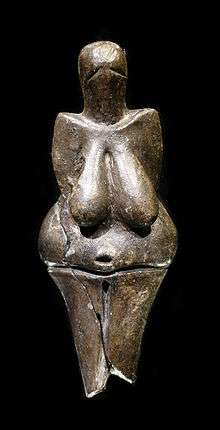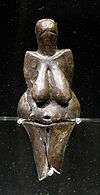Venus of Dolní Věstonice
The Venus of Dolní Věstonice (Czech: Věstonická venuše) is a Venus figurine, a ceramic statuette of a nude female figure dated to 29,000–25,000 BCE (Gravettian industry). It was found at the Paleolithic site Dolní Věstonice in the Moravian basin south of Brno, in the base of Děvín Mountain, 549 metres (1,801 ft). This figurine and a few others from locations nearby are the oldest known ceramic articles in the world.[1]
| Venus of Dolní Věstonice | |
|---|---|
 | |
| Material | Ceramic |
| Created | 29,000 BCE – 25,000 BCE |
| Discovered | 1925 in Moravia |
| Present location | Moravské zemské muzeum, Brno, Czech Republic |
Description
It has a height of 111 millimetres (4.4 in), and a width of 43 millimetres (1.7 in) at its widest point and is made of a clay body fired at a relatively low temperature (500 °C - 800 °C).[2] The statuette follows the general morphology of the other Venus figurines: exceptionally large breasts, belly and hips, perhaps symbols of fertility, relatively small head and little detail on the rest of the body.
The palaeolithic settlement of Dolní Věstonice in Moravia, a part of Czechoslovakia at the time organized excavation began, now located in the Czech Republic, has been under systematic archaeological research since 1924, initiated by Karel Absolon. In addition to the Venus figurine, figures of animals – bear, lion, mammoth, horse, fox, rhino and owl – and more than 2,000 balls of burnt clay have been found at Dolní Věstonice.
The figurine was discovered on 13 July 1925 in a layer of ash, broken into two pieces. Once on display at the Moravian Museum in Brno, it is now protected and only rarely accessible to the public. It was exhibited in the National Museum in Prague from 11 October 2006 until 2 September 2007 as a part of the exhibition Lovci mamutů (The Mammoth Hunters).[3][4][5] It was presented in the Moravian Museum in Brno at an expo "Prehistoric Art in Central Europe". It has returned to depository as of June 2009.[6] Scientists periodically examine the statuette. A tomograph scan in 2004 found a fingerprint of a child estimated at between 7 and 15 years of age, fired into the surface; the child who handled the figurine before it was fired is considered by Králík, Novotný and Oliva (2002) to be an unlikely candidate for its maker.[7]
Gallery
 Venus of Dolní Věstonice
Venus of Dolní Věstonice Venus of Dolní Věstonice (back)
Venus of Dolní Věstonice (back) Venus of Dolní Věstonice (left side)
Venus of Dolní Věstonice (left side) Venus of Dolní Věstonice (right side)
Venus of Dolní Věstonice (right side)
![]()
See also
References
- The body used is the local loess, with only traces of clay; there is no trace of surface burnishing or applied pigment. Pamela B. Vandiver, Olga Soffer, Bohuslav Klima and Jiři Svoboda, "The Origins of Ceramic Technology at Dolni Věstonice, Czechoslovakia", Science, New Series, 246, No. 4933 (November 24, 1989:1002-1008).
- Vandiver, Pamela B.; Soffer, Olga; Klima, Bohuslav; Svoboda, Jiři (November 24, 1989). "The Origins of Ceramic Technology at Dolni Věstonice, Czechoslovakia". Science. 246 (4933). pp. 1002–1008. JSTOR 1704937.
- Mammoth Hunters at the National Museum Archived June 11, 2007, at the Wayback Machine, information at the official website of the Czech Republic
- Primal Bohemia, The Prague Post, October 18, 2006
- Lovci mamutů, information on the web of the National Museum (in Czech)
- Venus of Dolní Věstonice and of Venus of Willendorf shown in Anthropos, Brno Now, June 26, 2009
- Králík, Miroslav; Novotný, Vladimír; Oliva, Martin (2002), "Fingerprint on the Venus of Dolní Věstonice I", Anthropologie, Moravské zemské muzeum, Brno, Czech Republic, 40/2: 107–113, ISSN 0323-1119, retrieved 2007-03-24
General Information
- National Geographic Society. Wonders of the Ancient World; National Geographic Atlas of Archaeology, Norman Hammond, Consultant, Nat'l Geogr. Soc., (Multiple Staff authors), (Nat'l Geogr., R.H.Donnelley & Sons, Willard, OH), 1994, 1999, Reg or Deluxe Ed., 304 pgs. Deluxe ed. photo (pg 248): "Venus, Dolni Věstonice, 24,000 B.C." In section titled: The Potter's Art, pp 246–253.